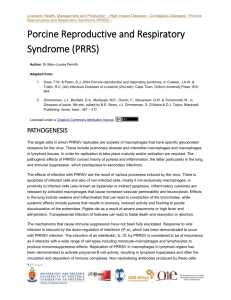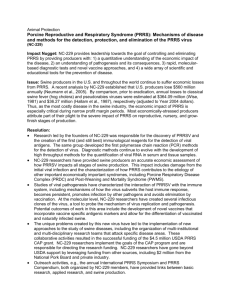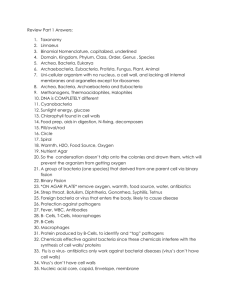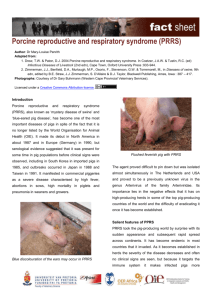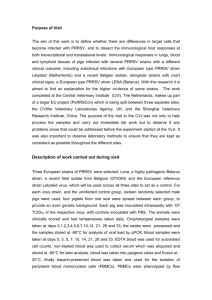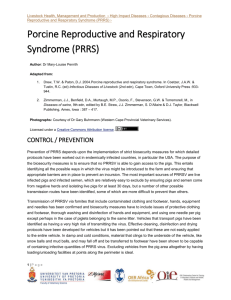Beneficiary Report
advertisement
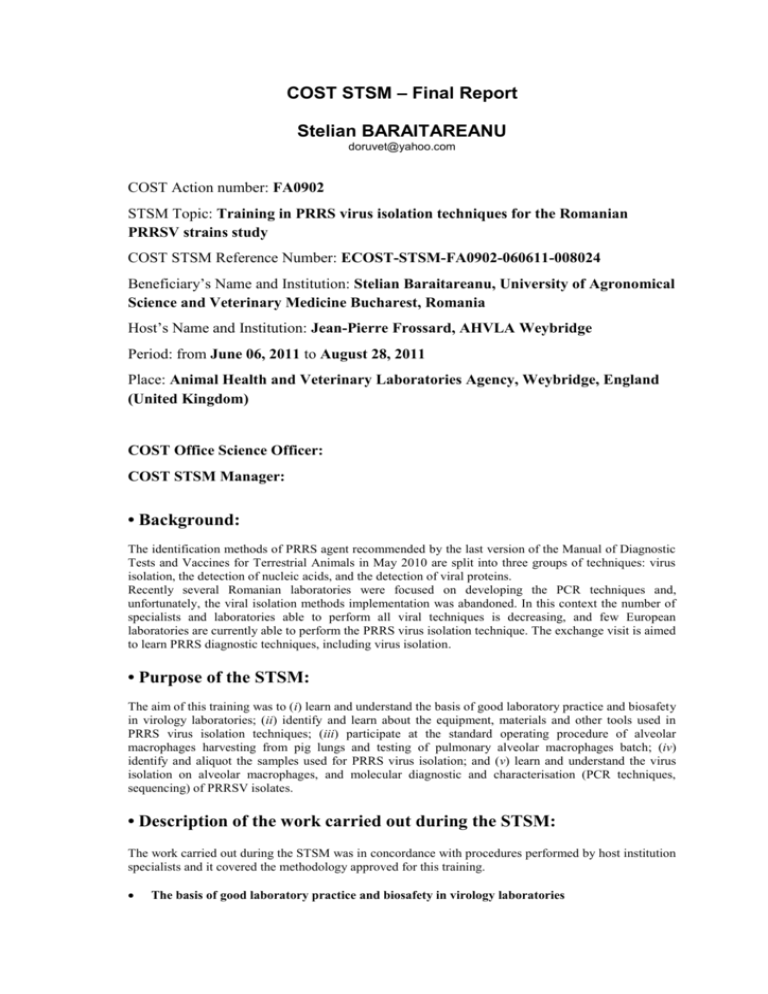
COST STSM – Final Report Stelian BARAITAREANU doruvet@yahoo.com COST Action number: FA0902 STSM Topic: Training in PRRS virus isolation techniques for the Romanian PRRSV strains study COST STSM Reference Number: ECOST-STSM-FA0902-060611-008024 Beneficiary’s Name and Institution: Stelian Baraitareanu, University of Agronomical Science and Veterinary Medicine Bucharest, Romania Host’s Name and Institution: Jean-Pierre Frossard, AHVLA Weybridge Period: from June 06, 2011 to August 28, 2011 Place: Animal Health and Veterinary Laboratories Agency, Weybridge, England (United Kingdom) COST Office Science Officer: COST STSM Manager: • Background: The identification methods of PRRS agent recommended by the last version of the Manual of Diagnostic Tests and Vaccines for Terrestrial Animals in May 2010 are split into three groups of techniques: virus isolation, the detection of nucleic acids, and the detection of viral proteins. Recently several Romanian laboratories were focused on developing the PCR techniques and, unfortunately, the viral isolation methods implementation was abandoned. In this context the number of specialists and laboratories able to perform all viral techniques is decreasing, and few European laboratories are currently able to perform the PRRS virus isolation technique. The exchange visit is aimed to learn PRRS diagnostic techniques, including virus isolation. • Purpose of the STSM: The aim of this training was to (i) learn and understand the basis of good laboratory practice and biosafety in virology laboratories; (ii) identify and learn about the equipment, materials and other tools used in PRRS virus isolation techniques; (iii) participate at the standard operating procedure of alveolar macrophages harvesting from pig lungs and testing of pulmonary alveolar macrophages batch; (iv) identify and aliquot the samples used for PRRS virus isolation; and (v) learn and understand the virus isolation on alveolar macrophages, and molecular diagnostic and characterisation (PCR techniques, sequencing) of PRRSV isolates. • Description of the work carried out during the STSM: The work carried out during the STSM was in concordance with procedures performed by host institution specialists and it covered the methodology approved for this training. The basis of good laboratory practice and biosafety in virology laboratories Theoretical study: - Working procedures and disposal of waste from the Mammalian Virology Group SAPO cat 0 to 2 labs Practical works: - Working with protective wear (laboratory coats, gloves, visors, glasses, face mask. - Identifying the nominated specialised rooms - Maintenance and room cleaning activities - Disposal of non-infectious and infectious waste Equipment, materials and other tools used in PRRS virus isolation techniques Theoretical study: - Working procedures with microbiological safety cabinet, fume hood, incubators, centrifuge, balance, pipettes, water baths, liquid nitrogen cryostore, x-ray developer Practical works: - Working with pipettes, microbiological safety cabinet, centrifuge, incubators. Harvesting of alveolar macrophages from lungs Theoretical study: - Standard operating procedures for preparation of primary lung macrophage cells in CTCS - Standard operating procedures for general cell culture practice - Standard operating procedures for cryopreservation of cells in liquid nitrogen - VLA Health & Safety Policy Practical works: - Alveolar macrophages harvesting from lungs of 5 week-old pigs for preparation of primary lung macrophage cells. - Alveolar macrophages harvesting from PRRSV infected pig lungs (35 d.p.i.) for pathogenesis research studies. Batch testing of alveolar macrophages Theoretical study: - Standard operating procedures for counting of cells - Standard operating procedures for assessment of cell cultures - Standard operating procedures for cryopreservation of cells in liquid nitrogen - Standard operating procedures for resuscitation of cells from liquid nitrogen - VLA Health & Safety Policy Practical works: - Test PLM batch for sensitivity to PRRS virus - Test PLM batch for diagnostic submissions Samples used for PRRS virus isolation Theoretical study: - Standard operating procedures for biosafety in virology laboratories - Standard operating procedures for PRRSV sampling - Standard operating procedures for aliquot of oral samples (cotton rope) - Standard operating procedures for processing and aliquot of oro-pharingeal liquid samples - Standard operating procedures for processing and aliquot of serum end plasma samples Practical works: - Aliquot of oral samples (cotton rope) received from the clinical study experiment of PRRS (swine experimental infection). - Processing and aliquot of oro-pharingeal liquid samples (cotton swabs) received from the clinical study experiment of PRRS (swine experimental infection). - Processing and aliquot of serum end plasma samples received from the clinical study experiment of PRRS (swine experimental infection). - Decontamination of cabinets and disposal of biological contaminated material Virus isolation on alveolar macrophages Theoretical study: - Standard operating procedures for PRRS immunoperoxidase monolayer assay - Standard operating procedures for PRRS immunoperoxidase monolayer assay plate production using MARC 145 cells - Standard operating procedures for isolation of PRRSV from serum or tissues, using pig lung macrophage cultures .1. Seeding macrophages in the microtitre plates Practical works: - Defrost the vials, washing the PLM cells with PBS, collecting in RPMI 1640 medium, and dispensing into microtitre plate. .2. Preparation of sample Practical works: - Dispensing growth medium in microtitre plates wells, adding the samples, and performing dilutions in dummy plates .3. Incubation of samples Practical works: - Incubate the microtitre plates with samples for 2–5 days and daily observation for CPE. - Perform the second passage .4. Reading and interpreting the results Practical works: - Examine cultures for cytopathic effects and contamination. .5. Immunostaining with a PRRSV-positive antiserum or MAb Practical works: - Wash, dry, fix and stain the plates infected with different PRRSV strains. PCR techniques and molecular characterisation (sequencing) of PRRSV isolates Theoretical study: - Standard operating procedures for biosafety in virology laboratories - Laboratory precautions for using PCR in diagnostic testing - ABI data collection software manual - ABI Sequence Analysis software manual - CSU DNA template – Clean un and Quantification - CSU ABI genetic Analyser Operation – Use and Maintenance - Samples preparation for PRRSV PCR (ORF5 and ORF7) - Standard operating procedures for PRRSV detection in serum an tissue using TaqMan PCR - Standard operating procedures for CSU ABI genetic Analyser – sample preparation Practical works: - Handling and storage of samples - Samples preparation for PRRSV nucleic acid sequencing (ORF7) by CSU ABI genetic Analyser - Interpretation of RT-PCR, q-PCR and sequencing results. • Description of the main results obtained: The training stage has been started with a brief theoretical training course about basis of good laboratory practice, biosafety in virology laboratories, and description of equipment, materials and other tools used in PRRS virus isolation techniques. Several exercises with protective wear, pipettes, microbiological safety cabinets and centrifuges have been daily performed. Skills in safety practice and appropriate risk assessments for these procedures were improved. PRRS virus is a fastidious agent which can be propagated on primary cultures of porcine alveolar macrophages (PAM) [Wensvoort et al., 1991]. Also, PRRSV (North American isolates) was achieved in the continuous cell lines ATCC VR-2332 and MARC-145 [Bautista et al., 1993; Benfield et al., 1992; Kim et al.,1993]. However, some isolates could be readily cultured in PAM, and others in continuous cell lines [Bautista et al., 1993; Kim et al., 1993]. In this context, it has been studied the procedures of alveolar macrophages harvesting from pig lungs, preparation of primary lung macrophage cells, and preparation of MARC 145 cells continuous cell lines. Also, it was performed batch testing for sensitivity and diagnostic purpose of those cell cultures. As a result of training, skills in cell culture practice were improved. One of the main problems in PRRSV diagnostics is the quality of sampling. Not all samples are the entire time positive during the virus infection, and the clinical trials and experimental infections still test the quality of different samples. In this training stage, different types of biological samples were processed: oral samples collected by cotton rope, oro-pharingeal liquid samples collected by cotton swabs, pulmonary lavage, lung and spleen tissue for molecular biology investigations, and serum and plasma samples received from a clinical study of PRRS experimental infection. Processing and aliquoting of different types of biological samples were followed by different methods of diagnostis (immunology, virology and nucleic acid detection). The practical activities improved the skills in PRRS diagnostic techniques. Virus isolation on alveolar macrophages and real-time PCR diagnostic methods were used to correlate the qPCR initial quantity copies and infectious particle values obtained by virus titration on pig lung macrophage cultures in serum samples collected from pigs experimentally infected with the PRRSVH2 strain. In this context, fifteen serum samples PRRSV-H2 strain positive were selected from the AHVLA Weybridge cryogenic bank. This selection has been based on previous information about virus load using a semi-quantitative method (number of positive wells in six replicates) of virus isolation on PAMs. All samples were selected on the basis of positive results and the variation of semi-quantitative results (from 1 to 6 positive PAM cell wells). PRRSV Lelystad strain has been used as positive control in virus titration and to make standard samples (six logarithmic dilutions) for qPCR. All 15 serum samples collected from pigs experimentally infected with PRRSV-H2 strain were positive in the microplate cell cultures used for virus titration. Fig. 1 PRRS virus identification by immunoperoxidase monolayer assay. Pam’s cytoplasm is deeply red and cytopathic effect is observed. All 15 serum samples collected from pigs experimentally infected with PRRSV-H2 strain have yielded positive RT-PCR results. The RNA initial quantities (copies) included in qPCR have been calculated by MCPro v.4.10 software with equation Ct = -3.821*LOG(copies) + 39.30 (fig. 2). This equation has been obtained by regression analysis of standard samples. All values have been between 3,700 and 37,000,000 copies/sample. Fig. 2. Real-Time PCR Quantitation results of 15 serum samples collected from pigs experimentally infected with PRRSV-H2 strain. The sample correlation coefficient of RNA copies/ml and Infectious particles/ml has been calculated to be 0.998. The strong correlation between qPCR and Virus Titration data suggest the possibility to evaluate the infectious particle load in all remaining samples in the study by using only qPCR. Also, it validates the use of qPCR to compare infectious particle load between samples, with a biological relevance. References 1. 2. 3. 4. Wensvoort, G., C. Terpstra, J. M. A. Pol, and M. White. 1991. Blue ear disease of pigs. Vet. Rec. 128:574. Bautista, E. M., S. M. Goyal, I. J. Yoon, H. S. Joo, and J. E. Collins. 1993. Comparison of porcine alveolar macrophages and CL 2621 for the detection of porcine reproductive and respiratory syndrome (PRRS) virus and anti-PRRS antibody. J. Vet. Diagn. Invest. 5:163-165. Benfield, D. A., E. Nelson, J. E. Collins, L. Harris, S. M. Goyal, D. Robinson, W. T. Christianson, R. B. Morrison, D. Gorcyca, and D. Chladek. 1992. Characterization of swine infertility and respiratory syndrome (SIRS) virus (isolate ATCC VR-2332). J. Vet. Diagn. Invest. 4:127-133. Kim, H. S., J. Kwang, I. J. Yoon, H. S. Joo, and M. L. Frey. 1993. Enhanced replication of porcine reproductive and respiratory syndrome (PRRS) virus in a homogeneous subpopulation of MA-104 cell line. Arch. Virol. 133:477-483. • Future collaboration with host institution: - Developing the virus bank of PRRSV strains circulating in Europe: Cooperative Agreement between University of Agronomical Sciences and Veterinary Medicine Bucharest and AHVLA Weybridge • Foreseen publications/articles resulting or to result from the STSM (if applicable): The data obtained in research of qPCR and Virus Titration on Cell Culture Monolyers correlation support the study of Dr. Tahar Ait-Ali and Dr Frossard, and will be included in a paper to be published in the coming year. • Confirmation by the host institution of the successful execution of the STSM: The scientific mission of Dr. Baraitareanu was completed successfully in all respects. His contribution to the work of the laboratory, particularly in relation to the PoRRSCon EU-funded project, was considerable. He was enthusiastic throughout his stay, interacting with scientists and veterinarians from several departments, and making full use of the facilities and resources available at AHVLA. The links established during this exchange will ensure that future collaboration between the two institutes will be readily undertaken. Future diagnostic and research efforts in the area of PRRSV in Romania will therefore benefit from the shared expertise of AHVLA scientists, as intended.
